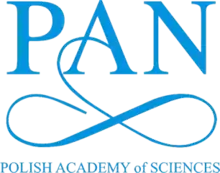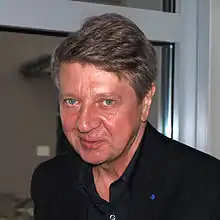 | |
 Staszic Palace, the seat of PAN, and Copernicus Monument | |
| Abbreviation | PAN |
|---|---|
| Formation | 30 October 1951[1] |
| Type | National academy, Academy of Sciences |
| Headquarters | Warsaw |
Region served | Poland |
President | Jerzy Duszyński |
| Website | pan |
Formerly called | Warsaw Scientific Society Warsaw Society of Friends of Learning |
The Polish Academy of Sciences (Polish: Polska Akademia Nauk, PAN) is a Polish state-sponsored institution of higher learning. Headquartered in Warsaw, it is responsible for spearheading the development of science across the country by a society of distinguished scholars and a network of research institutes. It was established in 1951, during the early period of the Polish People's Republic following World War II.[2]
History
The Polish Academy of Sciences is a Polish state-sponsored institution of higher learning, headquartered in Warsaw, that was established by the merger of earlier science societies, including the Polish Academy of Learning (Polska Akademia Umiejętności, abbreviated PAU), with its seat in Kraków, and the Warsaw Society of Friends of Learning (Science), which had been founded in the late 18th century.[3]
The Polish Academy of Sciences functions as a learned society acting through an elected assembly of leading scholars and research institutions. The Academy has also, operating through its committees, become a major scientific advisory body. Another aspect of the Academy is its coordination and overseeing of numerous (several dozen) research institutes. PAN institutes employ over 2,000 people and are funded by about a third of the Polish government's budget for science.[4]
Leadership
The Polish Academy of Sciences is led by a President, elected by the assembly of Academy members for a four-year term, together with a number of Vice Presidents.
The President for the 2019–2022 term was Jerzy Duszyński (his second term in the post),[5] together with five Vice Presidents: Stanisław Czuczwar, Stanisław Filipowicz, Paweł Rowiński, Roman Słowiński, and Romuald Zabielski.[6]
On 20 October 2022, General Assembly of the Polish Academy of Sciences elected Marek Konarzewski to become the new President of the Academy for the 2023–2026 term.[7][8] On 8 December 2022, another session of General Assembly of the Academy elected four Vice Presidents at the recommendation of the President Elect; as such Mirosława Ostrowska, Natalia Sobczak, and Dariusz Jemielniak, and Aleksander Welfe were elected as Vice Presidents of the Academy for the 2023–2026 term.
All the Presidents of the Polish Academy of Sciences to date, by term, are as follows:
- 1952–1956: Jan Bohdan Dembowski
- 1957–1962: Tadeusz Kotarbiński
- 1962–1971: Janusz Groszkowski
- 1971–1977: Włodzimierz Trzebiatowski
- 1977–1980: Witold Nowacki
- 1980–1983: Aleksander Gieysztor
- 1984–1990: Jan Karol Kostrzewski
- 1990–1992: Aleksander Gieysztor
- 1993–1998: Leszek Kuźnicki
- 1999–2001: Mirosław Mossakowski
- 2002–2003: Jerzy Kołodziejczak
- 2003–2006: Andrzej Legocki
- 2007–2014: Michał Kleiber
- 2015–2018: Jerzy Duszyński
- 2019–2022: Jerzy Duszyński
- 2023–2026: (president-elect) Marek Konarzewski
Institutes
_Invernadero_(3).png.webp)

The Polish Academy of Sciences has numerous institutes, including:
- Hirszfeld Institute of Immunology and Experimental Therapy
- Nencki Institute of Experimental Biology
- Bohdan Dobrzański Institute of Agrophysics
- Museum and Institute of Zoology
- Kielanowski Institute of Animal Physiology and Nutrition
- Mammal Research Institute of the Polish Academy of Sciences
- Institute of Pharmacology of the Polish Academy of Sciences[9] - established, 1954, became an independent institute in 1974; publishes the journal Pharmacological Reports.
- Institute of Psychology
- Institute of High Pressure Physics
- Nicolaus Copernicus Astronomical Center
- Institute of Fundamental Technological Research
- Institute of Metallurgy and Materials Science
- Polish Institute of Physical Chemistry
- Centre of Molecular and Macromolecular Studies, Polish Academy of Sciences in Lodz
- Department of Turbine Dynamics and Diagnostics of the Institute of Fluid-flow Machinery of the Polish Academy of Sciences
- Institute of Mathematics of the Polish Academy of Sciences
- Institute of Computer Science of the Polish Academy of Sciences
- Institute of Theoretical and Applied Informatics, Polish Academy of Sciences
- Institute for the History of Science, Polish Academy of Sciences
- Institute of Economics of the Polish Academy of Sciences
- Institute of Physics of the Polish Academy of Sciences
Notable members
- Bogdan Baranowski, chemist
- Franciszek Bujak, historian
- Tomasz Dietl, physicist
- Aleksandra Dunin-Wąsowicz, archaeologist
- Zofia Hilczer-Kurnatowska, archaeologist
- Maria Janion, scholar, critic and theoretician of literature
- Zofia Kielan-Jaworowska, paleontologist
- Franciszek Kokot, nephrologist
- Stanisław Konturek, physician
- Leszek Kołakowski, philosopher
- Roman Kozłowski, paleontologist
- Jacek Leociak, literary scholar
- Wanda Leopold, author, translator, and literature critic
- Mieczysław Mąkosza, chemist
- Zenon Mariak, neurosurgeon, professor
- Zenon Mróz, engineer
- Karol Myśliwiec, archeologist
- Witold Nowacki, mathematician (president of the Academy 1978 to 1980)
- Czesław Olech, mathematician
- Bohdan Paczyński, astrophysicist
- Włodzimierz Ptak, immunologist
- Marianna Sankiewicz-Budzyńska electronics engineer and academic
- Andrzej Schinzel, mathematician
- Jan Strelau, psychologist
- Zofia Sulgostowska, archaeologist
- Piotr Sztompka, sociologist
- Joanna Tokarska-Bakir, anthropologist and religious studies scholar
- Andrzej Trautman, physicist
- Andrzej Udalski, astrophysicist and astronomer
- Jerzy Vetulani, pharmacologist and neuroscientist
- Jan Woleński, philosopher
- Aleksander Wolszczan, astronomer
- Bernard Zabłocki, microbiologist and immunologist
- Stanisław Zagaja, pomologist, professor and director of Research Institute of Pomology and Floriculture
Foreign members


- Aage Bohr, physicist
- Zbyszek Darzynkiewicz, cell biologist
- Joseph H. Eberly, physicist
- Erol Gelenbe, computer scientist and engineer
- Martin Hairer, mathematician
- Jack K. Hale, mathematician
- Stephen T. Holgate, immunopharmacologist (2001)[10]
- Ernst Håkon Jahr, linguist
- Krzysztof Matyjaszewski, Polish chemist working at Carnegie Mellon University
- Karl Alexander Müller, physicist
- Roger Penrose, mathematician
- Carlo Rubbia, physicist
- Peter M. Simons, philosopher
- Boleslaw Szymanski, computer scientist
- Chen Ning Yang, physicist
- George Zarnecki, art historian
Periodicals
See also
References
- ↑ "Instytucja Naukowa - Dzieje instytucji". Archived from the original on 2014-08-04. Retrieved 2014-08-13.
- ↑ Hübner, P. (1987). Nauka polska po II wojnie światowej – idee i instytucja. Warsaw. pp. 143–144.
{{cite book}}: CS1 maint: location missing publisher (link) - ↑ "Instytucja Naukowa - Dzieje instytucji". Archived from the original on 2014-08-04. Retrieved 2014-08-13.
- ↑ Ustawa z dnia 30 kwietnia 2010 r. o Polskiej Akademii Nauk.
- ↑ "Prezes". Polish Academy of Sciences. Archived from the original on 28 October 2018. Retrieved 30 September 2019.
- ↑ "Wiceprezesi". Polish Academy of Sciences. Archived from the original on 24 January 2019. Retrieved 30 September 2019.
- ↑ "Prof. Marek Konarzewski wybrany na stanowiska prezesa PAN". Polska Agencja Prasowa SA (in Polish). Archived from the original on 2022-10-23. Retrieved 2022-10-23.
- ↑ "Prof. Marek Konarzewski nowym prezesem Polskiej Akademii Nauk" (in Polish). Rzeczpospolita. Archived from the original on 2022-10-20. Retrieved 2022-10-21.
- ↑ Thomas A Ban; Hanns Hippius (6 December 2012). Thirty Years CINP: A Brief History of the Collegium Internationale Neuro-Psychopharmacologicum. Springer Science & Business Media. pp. 153–. ISBN 978-3-642-73956-9.
- ↑ "Academia Europaea: Holgate Stephen Townley". AE-Info.org. Archived from the original on 2019-02-21. Retrieved 2019-02-20.
2001 Overseas Member, Polish Academy of Sciences.
External links
- PAN website (click on British flag icon for English-language content)
.jpg.webp)
